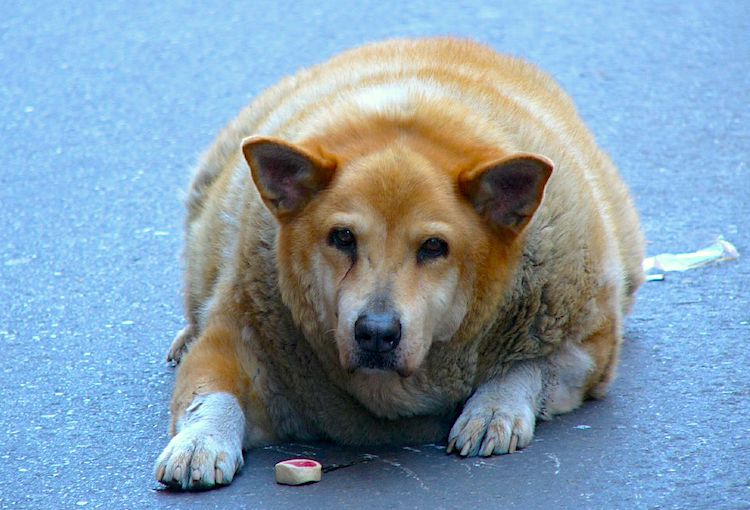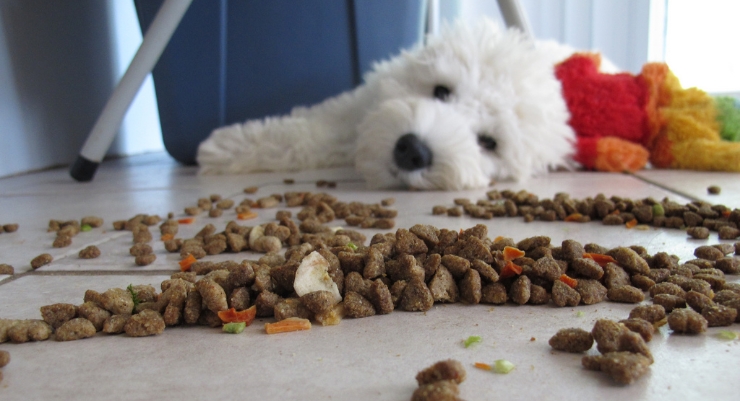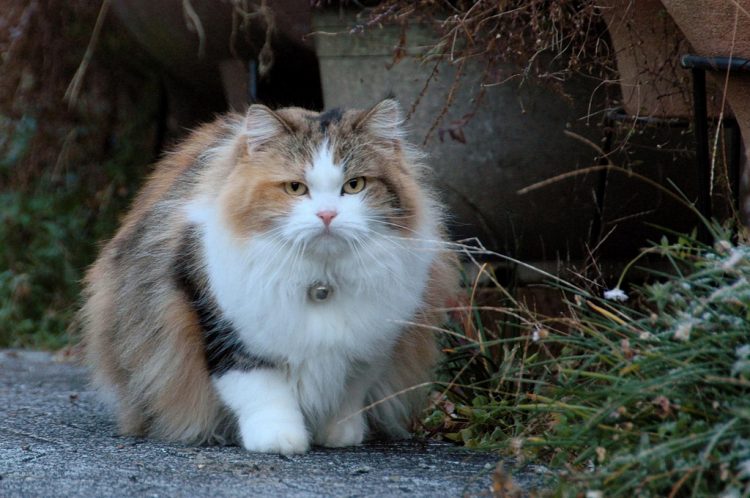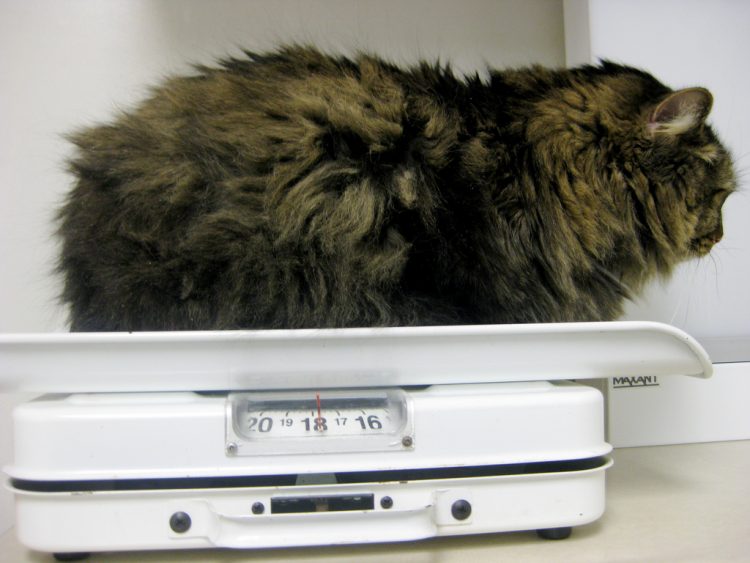
You’re probably sick and tired of hearing about Americans’ pets being fat.
In fact, you might have seen headlines like these:
- “The Obesity Pet Crisis in America”
- “Health Risks Associated With Overweight Pets”
- “How to Help Your Pets Lose Weight”
But know this: Being overweight is the most common health threat to dogs and cats, and it’s a medical concern of epidemic proportions.
About 60% of Pets Are Overweight
According to a survey from the Association for Pet Obesity Prevention (APOP) that was published in 2019, an astounding 59.5% of cats and 55.8% of dogs are overweight or obese in the United States.
Even worse, the vast majority of pet parents are unaware their pets are overweight. “We’ve made fat pets the new normal,” says Dr. Ernie Ward, DVM, who is the founder of APOP and author of Chow Hounds: Why Our Dogs Are Getting Fatter.
This normalization of obesity (the “fat gap”) means most people don’t understand the potentially life-threatening health consequences that arise from their pet being overweight, such as:

Pet Parents in Denial
Denial can lead to shock when a veterinarian tells a pet parent that their picture-perfect pet is actually overweight.
Our job as vets is not just telling clients about their pets’ weight and the consequences — but also convincing them that their 15-pound cat is not at a normal weight. Or that a normal Beagle does not weigh 50 pounds.
Our pets are overweight — and, yes, lots of us are, too. In fact, 71.6% of American adults are overweight or obese.
“It is likely that the [pet parent] feels a bit guilty that they are eating and their pet is not, so they reward the dog [or cat] with unearned and calorically unneeded treats. If this becomes a habitual form of behavior, the obvious result is a plump dog,” says Stanley Coren, PhD, DSc, FRSC, an expert in canine psychology.
During wellness exams with an overweight pet, veterinarians try to take it slow and get a feel for how the pet parent identifies with food, not only for themselves but also for their pet. No insults, but calm truth.
The Consequences of Obesity in Dogs and Cats
Being overweight affects a pet’s quality of life in many ways. It can also affect lifespan.
A classic study, the Purina Lifespan Study, showed that thin dogs outlive chubby dogs by an average of 1.8 years.
As you can see, looking at overweight and obesity in dogs and cats as simply a cosmetic problem is a serious misconception. There are serious, life-threatening consequences.

Top 5 Consequences of Dog Obesity
1. Poor Quality of Life — And a Shorter Life
BCS stands for body condition score, 1 being starvation and 10 being morbidly obese.
As mentioned before, the Purina Lifespan Study found that dogs with an ideal BCS lived about 1.8 years longer than their overweight counterparts. The slimmer dogs also had delayed onset of chronic disease.
Remember that ideal weight means a better and longer life.
Was YOUR Pet Food Recalled?
Check Now: Blue Buffalo • Science Diet • Purina • Wellness • 4health • Canine Carry Outs • Friskies • Taste of the Wild • See 200+ more brands…

2. Osteoarthritis
Leaner dogs in the lifespan study experienced later onset of arthritis and less pain and lameness than heavier dogs.
Even a small loss of body fat improved mobility and lessened lameness problems.
3. Intervertebral Disk Disease (IVDD)
This is a sad condition that, in the worst case, can paralyze a dog.
Any dog can suffer from disk disease, but long-backed breeds are especially susceptible, such as the Miniature Dachshund — the poster pup for IVDD.
If your Dachshund or Corgi is overweight, even just a little, the risk for a disk problem is greater. And if your dog suffers from a severe disk extrusion and undergoes surgery to correct it, understand that dogs at a healthier weight make a faster recovery.
4. Subclinical Conditions
Overweight dogs, like people, are more prone to inflammation in the body, high cholesterol and high lipids — all of which can lead to pancreatitis, diabetes, gastrointestinal disease and more.
Slimming down an obese dog can ward off chronic conditions that are often difficult to diagnose.
5. Breathing and Heart Problems
Obese dogs can have more trouble breathing or worsen a preexisting condition, like collapsing trachea or laryngeal paralysis.
Excess weight can also make the heart work harder, so keeping extra weight off your dog makes for a better life — and fewer vet visits.
Isn’t it more fun for you to go for a jog with your dog than to bring them in for breathing or arthritic problems?
Daily Calories for Dogs
- A recommended calorie intake for dogs is 30 calories for every 1 pound (ideal) body weight.
- Thus, a small Labrador Retriever needs around 980 calories a day, while that same Lab on a diet needs just 650 calories a day.

Top 5 Consequences of Cat Obesity
1. Diabetes
Oddly enough, obesity actually adds to more overt disease in cats than in dogs. Obese cats are far more prone to diabetes, an expensive and worrisome condition to treat.
2. Urinary Problems
Maintaining a good weight lowers your cat’s risk of lower urinary tract disease.
Normal-weight cats are more active, less stressed and have more enriched lives. Less stress, we believe, means fewer urinary tract problems.
3. Osteoarthritis
Similar to dogs, obese cats suffer from more arthritic pain than normal-weight cats.
Most arthritis is a degenerative condition found in aging cats. Think of older indoor cats who’ve munched on only dry food for the past 15 years:
- They are obese.
- They can’t reach their backs to groom.
- And they’re putting excess stress on every joint every time they jump down from the food bowl.
The brief answer is wet food instead of dry, as well as portion control and more exercise.
4. Subclinical Conditions
Cats can hide subclinical disease very well. Pancreatitis, gastrointestinal disease and even early diabetes can go unnoticed for a while.
Get your cat back to a healthy weight before these conditions set in.
5. Poor Quality of Life — and a Shorter Life
Remember, we are the keepers of the pantry. We are to blame for putting our pets at risk from obesity.
Daily Calories for Cats
- An indoor cat needs 20 calories per 1 pound of body weight, and an outdoor cat almost twice as much, at 35 calories.
- Each piece of kibble contains around 2 to 3 calories. Put 60 kibble bits in a pile, and it doesn’t look much.
How to Be Treat-Aware
Be wary of the hidden calories in treats.
In fact, why not measure out your pet’s daily allowance, then save some in a container? Then you have the pleasure of giving a reward without piling on the pounds.
Or, even better, as Dr. Debora Lichtenberg, VMD, puts it: “Turn your back on the advertising. Turn your back on the impulse buy to bring home a treat for your pet. There are healthier alternatives. Open the refrigerator. Make your own! The majority of the treats are unhealthy, overpriced, cause obesity and have no value.”
Give healthy treats, such as fresh vegetables: carrots, beans or broccoli. This may work better for dogs than cats, but you can certainly try.

Food Means More Than Nourishment
Feeding your pet nourishes them, but it also nourishes you.
Americans have such a strong human–animal bond, and feeding pets signifies much more than a daily calorie count — it translates as love for many people.
But we’ve taken things too far.
If you’re in the mood for shock tactics, it turns out that a 1-ounce cube of cheddar cheese fed as a treat to a 20-pound dog is like giving them a cheeseburger.
It gets worse. For a cat, that same 1-ounce cube of cheese comes in at 2.5 cheeseburgers.
Reality Check
A veterinarian’s typical pet weight-loss talk addresses:
- Amounts of food
- Types of food
- Canned food for cats and no grazing
- Beginning mild-to-moderate exercise programs
- Going on a prescription diet
- “Weigh-in” appointments
- Computer-generated weight loss programs
When we tell our clients about correct nutrition, some go home and do whatever they want, but we’ve had some decent results with many overweight pets.

5 Tips to Get Your Pet to a Healthier Weight
1. Consult your veterinarian.
Dr. Carolyn McDaniel, VMD, of Cornell University’s College of Veterinary Medicine says that any weight-loss program “should be carried out under the direction of a veterinarian.”
“What you want to aim for is a gradual weight loss, perhaps 1–2% loss of body weight per week,” she says. Bring your dog or cat to the vet for a weigh-in. From there, discuss options for weight loss and get recommendations on what type of food would best fit your pet’s lifestyle.
The vet will take into account the breed, age and activity level.
2. For cats, no grazing.
Dr. Elizabeth Hodgkins, DVM, author of Your Cat: Simple New Secrets to a Longer, Stronger Life, recommends wet food rather than dry for cats.
But perhaps more important, she says, is removing the all-you-can-eat buffet.
“Whatever wet food you choose for your cat, do not free-feed additional dry food alongside,” says Dr. Hodgkins. “Cats do not need to ‘graze’ on a constant basis as if they were cattle.”
Dr. Hodgkins adds: “Twice-daily meal feeding of wet food at about 3–4 ounces of food per meal simulates the cat’s free roaming feeding behaviors as closely as humanly possible and allows the cat to maintain a healthy adult weight throughout its life.”
Changing this behavior is the first step in helping your cat to lose weight.
3. Make your pet work for food.
Consider making mealtime an interactive activity.
Instead of regular food bowls, try using puzzle feeders so the cat or dog learns the powerful lesson that “nothing in life is free” when it comes to food. Dry food works well in these circumstances.
Weigh out the daily allowance of food at breakfast time, load up the puzzle feeders and hide small saucers around the house. Then leave your pet to it.
4. Don’t overfeed.
This one seems relatively simple: We’re feeding our pets more than they need.
Instead of just dumping food into the bowl, read the labels to see what the recommended servings are. Then use a measuring cup so portions are accurate.
5. Get more exercise.
- For cats, see our article “10 Fresh and Easy Ways to Exercise a Cat.”
- For dogs, see “How to Exercise Your Dog Anytime — Even in the Winter.”
In this Animal Planet video, these portly pups and flabby tabbies get “big fat pet makeovers”:

Millennials Are Way Ahead of the Game
As a group, millennials seem more food conscious, more exercise conscious and more understanding of wellness medicine — plus, on the whole, they don’t let their younger pets get obese. Weight management is a lot easier if you don’t have to return to normalcy from obesity.
Our final thoughts?
- Eat well, eat healthy, and move both yourself and your pets.
- If you’re concerned that your pet may be overweight, please discuss it with your veterinarian.
References
- “U.S. Pet Obesity Rates Plateau and Nutritional Confusion Grows.” Association for Pet Obesity Prevention. March 12, 2019. https://static1.squarespace.com/static/597c71d3e58c621d06830e3f/t/5c86da47c83025a824d387ae/1552341575308/2018+APOP+Survey+Press+Release.pdf.
- Bassam, Nahla. “About Those New Year’s Resolutions….” Foundation for Biomedical Research. Jan. 5, 2018. https://fbresearch.org/new-years-resolutions/.
- “Obesity and Overweight.” Centers for Disease Control and Prevention. https://www.cdc.gov/nchs/fastats/obesity-overweight.htm.
- Coren, Stanley, PhD, DSc, FRSC. “Overweight Pet Owners Are Likely to Have Overweight Dogs.” Psychology Today. July 24, 2019. https://www.psychologytoday.com/us/blog/canine-corner/201907/overweight-pet-owners-are-likely-have-overweight-dogs.
- Kealy, R.D., et al. “Effects of Diet Restriction on Life Span and Age-Related Changes in Dogs.” Journal of the American Veterinary Medical Association 220, no. 9 (May 2002): 1315–1320. https://avmajournals.avma.org/doi/abs/10.2460/javma.2002.220.1315.
- “Purina Study Confirms Link Between Body Fat and Chronic Health Conditions.” Purina. September 30, 2003.
- Zeltzman, Phil, DVM, DACVS, CVJ, and Rebecca A. Johnson, PhD, RN, FAAN. Walk a Hound, Lose a Pound: How You and Your Dog Can Lose Weight, Stay Fit and Have Fun Together. Purdue University Press. 2011. 49. https://books.google.com/books?id=Fh3ZJkUNPFcC&pg=PA49#v=onepage&q&f=false.
- Linder, Deborah, DVM, DACVN, “Top 5 Clinical Consequences of Obesity,” Clinician’s Brief 12, no. 2. (February 2014). http://www.cliniciansbrief.com/article/top-5-clinical-consequences-obesity.
- Williams, Krista, DVM, and Ernest Ward, DVM. “Creating a Weight Reduction Plan for Cats.” VCA Hospitals. https://vcahospitals.com/know-your-pet/creating-a-weight-reduction-plan-for-cats.
- “Obesity.” Cornell Feline Health Center of the Cornell University College of Veterinary Medicine. 2016. https://www.vet.cornell.edu/departments-centers-and-institutes/cornell-feline-health-center/health-information/feline-health-topics/obesity.
- Hodgkins, Elizabeth, DVM. Your Cat: Simple New Secrets to a Longer, Stronger Life. Macmillan. 2008. 119.
 This article on obesity in dogs and cats was written by veterinarians, Dr. Debora Lichtenberg, VMD, Dr. Pippa Elliott, BVMS, MRCVS, and Dr. Phil Zeltzman, DVM, DACVS, CVJ. As the author of the 2011 book Walk a Hound, Lose a Pound, Dr. Zeltzman has specific expertise in the area of pet obesity. This article was originally published in 2013 and is regularly updated. It was last reviewed for accuracy and updated July 10, 2020.
This article on obesity in dogs and cats was written by veterinarians, Dr. Debora Lichtenberg, VMD, Dr. Pippa Elliott, BVMS, MRCVS, and Dr. Phil Zeltzman, DVM, DACVS, CVJ. As the author of the 2011 book Walk a Hound, Lose a Pound, Dr. Zeltzman has specific expertise in the area of pet obesity. This article was originally published in 2013 and is regularly updated. It was last reviewed for accuracy and updated July 10, 2020. 


